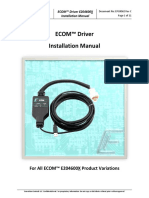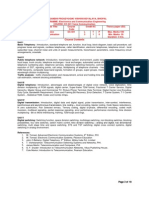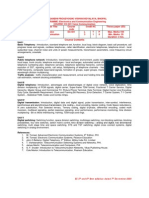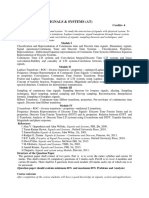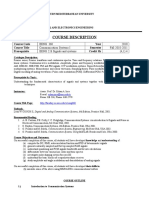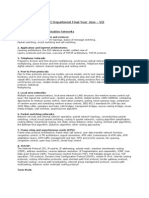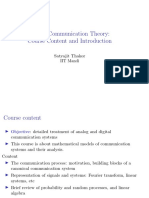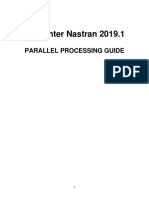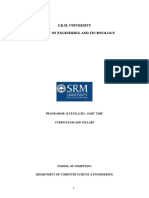0 ratings0% found this document useful (0 votes)
4 viewsADC EE Syllabus
ADC EE Syllabus
Uploaded by
Deepjoy DasCopyright:
© All Rights Reserved
Available Formats
Download as PDF, TXT or read online from Scribd
ADC EE Syllabus
ADC EE Syllabus
Uploaded by
Deepjoy Das0 ratings0% found this document useful (0 votes)
4 views2 pagesOriginal Title
ADC_EE_Syllabus (1)
Copyright
© © All Rights Reserved
Available Formats
PDF, TXT or read online from Scribd
Share this document
Did you find this document useful?
Is this content inappropriate?
Copyright:
© All Rights Reserved
Available Formats
Download as PDF, TXT or read online from Scribd
Download as pdf or txt
0 ratings0% found this document useful (0 votes)
4 views2 pagesADC EE Syllabus
ADC EE Syllabus
Uploaded by
Deepjoy DasCopyright:
© All Rights Reserved
Available Formats
Download as PDF, TXT or read online from Scribd
Download as pdf or txt
You are on page 1of 2
NATIONAL INSTITUTE OF TECHNOLOGY SILCHAR- SILCHAR- ASSAM-788010-INDIA/UG CURRICULA/w.e.f.
2018 batch
EC 327 Analog and Digital Communication L T P C
B. Tech (Electrical Engg.) Sixth Semester 3 0 0 3
Unit-1: The history of evolution of Electrical Communication, Concept of (10)
information, messages and signals, knowledge of Signals and Information
representation, elements of a communication system, Communication
channels, Base band and pass band signals, Fundamental limitations, Fourier
transform, Properties of the Fourier transform, Parseval's theorem, Rayleig’s
energy theorem, Dirac-Delta function, Fourier transform of Periodic linear
systems. Representation of energy and power signals and their spectral
density; External noise, internal noise, Noise calculations, signal to noise
ratio.
Unit-2: Amplitude modulation and spectra, DSB Signals and spectra, Tone
modulation and phasor analysis, Switching modulator, Envelope detector, (12)
Ring modulator and balanced modulator, Single side band modulation, Phase
Shift method for generation of SSB, Phase and frequency modulation,
Narrowband F.M, Wideband F.M, Transmission B.W. of F.M. signal,
Generation of F.M. signal. Indirect F.M. & Direct F.M, Demodulation of F.M.
signal using balanced frequency discrimination. AM transmitters and
receivers, super heterodyne receiver, IF amplifiers, AGC circuits.
Unit-3: Concept of random variables, Probability density function and probability (6)
distribution function of random variable, Mean & Mean square value of a
R.V, Concept of Stochastic Process, Ensemble averages and correlation
function, Stationary and Ergodic Process, Signal Power, Time average and
Power spectral density, Shot noise, Thermal noise and White noise.
Unit-4: Sampling Process, Sampling Theorem (only statement), Analogy Pulse (12)
modulation : PAM, PPM and PDM, Time Division Multiplexing,
Quantization Process (only uniform quantization), Quantization noise, Pulse
code modulation, Delta modulation, Differential Pulse Code modulation, Base
band Pulse Transmission concept., Method filter, Pass band transmission
model, Gram Schmidt Orthogonalization principle, Geometrical
interpretation of signal, Digital modulation techniques, Coherent binary PSK,
Coherent binary FSK, Coherent quadriphase shift keying. Introduction to
information theory.
Text and Reference:
1. Simon Haykin .Communication Systems. PHI
2. B. P. Lathi. Modern Digital and Analog Communications. Oxford Univ. Press
3. John Proakis .Digital Communications. McGraw Hill
4. Taub and Schilling. Principles of Communication Systems. McGraw Hill I.E.
5. Wayne Tomasi . Electronic Communications System: Fundamentals Through
Advanced, 5/e . Pearson Education
SYLLABI FOR DEPARTMENT OF ELECTRICAL ENGINEERING 211 | P a g e
NATIONAL INSTITUTE OF TECHNOLOGY SILCHAR- SILCHAR- ASSAM-788010-INDIA/UG CURRICULA/w.e.f. 2018 batch
Course Outcomes (Cos):
At the end of the course the students will be able to
1. demonstrate the different techniques of communication system, its elements,
facts to be considered in choosing a communication system, frequency analysis,
different communication channels, their merits and limits.
2. evaluate different modulation techniques in analog as well as in digital communication,
their operation, merits and demerits.
3. implement sampling theorem, different techniques, merits and demerits to solve
engineering problems
SYLLABI FOR DEPARTMENT OF ELECTRICAL ENGINEERING 212 | P a g e
You might also like
- Front End Programming: Mendel RosenblumDocument13 pagesFront End Programming: Mendel RosenblumViuleta SunNo ratings yet
- Ecom Driver Installation ManualDocument11 pagesEcom Driver Installation ManualKurd SkorvskiNo ratings yet
- Review Summary Chapter 5: It Infrastructure and Emerging TechnologiesDocument1 pageReview Summary Chapter 5: It Infrastructure and Emerging Technologiesghina adhha hauraNo ratings yet
- Syllabus 2013 PDFDocument41 pagesSyllabus 2013 PDFAbhay RameshNo ratings yet
- VI EC - Sy - 311212042539Document7 pagesVI EC - Sy - 311212042539aduveyNo ratings yet
- Course Contents: Unit I Basic TelephonyDocument7 pagesCourse Contents: Unit I Basic TelephonyRITESH KUMAR PANDEYNo ratings yet
- Course Contents: Unit I Basic TelephonyDocument7 pagesCourse Contents: Unit I Basic TelephonyKavita BurseNo ratings yet
- CT SyllaDocument2 pagesCT SyllaBrindha RajuNo ratings yet
- 13.302 Signals & Systems (At) : L-T-P: 3-1-0 Credits: 4Document7 pages13.302 Signals & Systems (At) : L-T-P: 3-1-0 Credits: 4Surya TejaNo ratings yet
- ECE Elective SyllabusDocument34 pagesECE Elective SyllabusPratyush ChauhanNo ratings yet
- Abha Mtech EceDocument20 pagesAbha Mtech EcePrashantyelekarNo ratings yet
- V Sem EC Syllabus 2023-24240823125611Document11 pagesV Sem EC Syllabus 2023-24240823125611Deepanshu BarveNo ratings yet
- B.E. Electronics & Telecom. Engineering: Semester VIIDocument13 pagesB.E. Electronics & Telecom. Engineering: Semester VIImahesh20moteNo ratings yet
- 4th Year SyllabusDocument17 pages4th Year Syllabusapi-350836154No ratings yet
- Eeng360 Fall2010 2011 Course DescriptDocument2 pagesEeng360 Fall2010 2011 Course DescriptEdmond NurellariNo ratings yet
- M Tech Syllabus ECEDocument16 pagesM Tech Syllabus ECEAbhishek BhatnagarNo ratings yet
- ECE Sem5 PDFDocument23 pagesECE Sem5 PDFbangs34No ratings yet
- Electronic CommunicationDocument2 pagesElectronic CommunicationHet PatelNo ratings yet
- 08-Electronics & Comm EnggDocument44 pages08-Electronics & Comm EnggIvan D'souzaNo ratings yet
- ECE Core Other SyllabusDocument6 pagesECE Core Other SyllabusPratyush ChauhanNo ratings yet
- JNTUH Syllabus 2013 M.tech Communication SysDocument26 pagesJNTUH Syllabus 2013 M.tech Communication SysSRINIVASA RAO GANTANo ratings yet
- Ec8491 Communication Theory UNIT I Amplitude Modulation 9Document1 pageEc8491 Communication Theory UNIT I Amplitude Modulation 9mrameshmeNo ratings yet
- M Tech Ec SyllabusDocument13 pagesM Tech Ec SyllabusDhaval PatelNo ratings yet
- Applicable From The Academic Session 2018-2019Document22 pagesApplicable From The Academic Session 2018-2019Debarshi GhoshNo ratings yet
- Course Curriculum B.TECH. (EC) II-Year, IV-Semester Theory Paper I L T P Credits 3 1 0 4 EC-211: Analog Integrated Circuits Unit-1Document6 pagesCourse Curriculum B.TECH. (EC) II-Year, IV-Semester Theory Paper I L T P Credits 3 1 0 4 EC-211: Analog Integrated Circuits Unit-1Dishant GargNo ratings yet
- SyllabusDocument7 pagesSyllabuspankaj kumarNo ratings yet
- ExtcDocument15 pagesExtcapi-236544093No ratings yet
- Btech (ECE) 7 and 8Document24 pagesBtech (ECE) 7 and 8junaidNo ratings yet
- JNTUK M.Tech R13 CNC SyllabusDocument18 pagesJNTUK M.Tech R13 CNC Syllabuschakri474No ratings yet
- ENEE3309 OutlineDocument5 pagesENEE3309 OutlineJLM SSNo ratings yet
- Section-A: MDU B.Tech Syllabus (ECE) - II YearDocument2 pagesSection-A: MDU B.Tech Syllabus (ECE) - II YearBindia HandaNo ratings yet
- Syllabus PHD Even Semester Nov 2022 ECE WOCDocument2 pagesSyllabus PHD Even Semester Nov 2022 ECE WOCsandeep_2262No ratings yet
- SyllabusDocument2 pagesSyllabussatheesh kumarNo ratings yet
- ME Communication Systems R 2007 SyllabusDocument27 pagesME Communication Systems R 2007 SyllabusKathiravan SrinivasanNo ratings yet
- IV B.E. (Bio-Medical Engineering)Document9 pagesIV B.E. (Bio-Medical Engineering)9y9aNo ratings yet
- I Analog Integrated Circuits (TEC-502)Document13 pagesI Analog Integrated Circuits (TEC-502)Suyash MaanNo ratings yet
- PG Etce Syllabus JuDocument14 pagesPG Etce Syllabus Jumithun_kumarNo ratings yet
- EE-402-E Wireless Communication: Text BooksDocument10 pagesEE-402-E Wireless Communication: Text BooksGopi Ram VermaNo ratings yet
- Ec8491 Communication Theory L T P CDocument2 pagesEc8491 Communication Theory L T P Cmadhupavi_2007No ratings yet
- Extc - 8th SemDocument43 pagesExtc - 8th SemmaddyextcNo ratings yet
- Me EceDocument39 pagesMe EceSenthilarasu SubramanianNo ratings yet
- EC-301 Information Theory and Coding Unit-IDocument5 pagesEC-301 Information Theory and Coding Unit-IDonald CadeNo ratings yet
- Sem 4Document16 pagesSem 4BeawaredangerNo ratings yet
- Semester-IV EC401 Analog Communication 3L:0T:0P 3 CreditsDocument15 pagesSemester-IV EC401 Analog Communication 3L:0T:0P 3 CreditsChayan KoleyNo ratings yet
- Course Syllabi (2016 - 2020) : Format No.: MITAOE/ACAD/ 002 Rev. No.: 0.0 Rev. Date: 01/12/2017Document4 pagesCourse Syllabi (2016 - 2020) : Format No.: MITAOE/ACAD/ 002 Rev. No.: 0.0 Rev. Date: 01/12/2017yogesh zalteNo ratings yet
- ECE 5th SemesterDocument10 pagesECE 5th SemesterMatt AustinNo ratings yet
- ME Digital Communication 2nd Sem SyllabusDocument5 pagesME Digital Communication 2nd Sem SyllabusPrakash SinhaNo ratings yet
- EC SyllabusDocument16 pagesEC Syllabusakash kumarNo ratings yet
- Proposed Scheme For M.E. (Electronics & Telecommunication Engineering)Document9 pagesProposed Scheme For M.E. (Electronics & Telecommunication Engineering)Prathamesh MestryNo ratings yet
- B.Tech - ECE Syllabus IV Year - Signal and System 3014Document3 pagesB.Tech - ECE Syllabus IV Year - Signal and System 3014tarang srivasNo ratings yet
- Text Books Gate EceDocument4 pagesText Books Gate EceGiri KandeNo ratings yet
- Compulsory Subjects: Syllabus of Electronics of Amie ExamsDocument22 pagesCompulsory Subjects: Syllabus of Electronics of Amie ExamsjaiganeshNo ratings yet
- Lecture1-Content IntroDocument15 pagesLecture1-Content IntroNIKINo ratings yet
- Analog Communications: Course Code:13EC1109 L TPC 4 0 0 3Document3 pagesAnalog Communications: Course Code:13EC1109 L TPC 4 0 0 3NISHCHAY SINGHNo ratings yet
- Digital Communication PartDocument6 pagesDigital Communication PartTejesh GowdaNo ratings yet
- Notice: Modified Syllabus of DCTDocument1 pageNotice: Modified Syllabus of DCTShivanee PrustyNo ratings yet
- Ac SyllabusDocument2 pagesAc SyllabusMARIYABABU SINGEPOGUNo ratings yet
- Signal Integrity: From High-Speed to Radiofrequency ApplicationsFrom EverandSignal Integrity: From High-Speed to Radiofrequency ApplicationsNo ratings yet
- RF Analog Impairments Modeling for Communication Systems Simulation: Application to OFDM-based TransceiversFrom EverandRF Analog Impairments Modeling for Communication Systems Simulation: Application to OFDM-based TransceiversNo ratings yet
- 09 Race ConditionsDocument93 pages09 Race ConditionsBabak KhoramdinNo ratings yet
- Slide Deck - Session 4Document21 pagesSlide Deck - Session 4Aniruddha LangheNo ratings yet
- Small Switching (60V, 2A) : TransistorsDocument4 pagesSmall Switching (60V, 2A) : TransistorsSuperlano JoséNo ratings yet
- 40-Ipl32l-Pwg1xg China Psu PDFDocument3 pages40-Ipl32l-Pwg1xg China Psu PDFmarceloNo ratings yet
- Compre Questions-Fall-12-131 1Document106 pagesCompre Questions-Fall-12-131 1api-240791352No ratings yet
- Pinpoint+Test+I+DTC+U1007,31Document9 pagesPinpoint+Test+I+DTC+U1007,31Rizki Akbar ErmansyahNo ratings yet
- Library Management SystemDocument43 pagesLibrary Management SystemdineshNo ratings yet
- S300 Laser Scanner Configuration ProtocolDocument6 pagesS300 Laser Scanner Configuration ProtocolCesar ChaconNo ratings yet
- Gate Cse Prev 28year QuestionDocument565 pagesGate Cse Prev 28year QuestionAbhishek TripathiNo ratings yet
- Orange DVR Firmware 0822Document1 pageOrange DVR Firmware 0822nisar NissarNo ratings yet
- Diode - Definition, VI Characteristics, and Breakdown in Zener Diode - DiodeDocument8 pagesDiode - Definition, VI Characteristics, and Breakdown in Zener Diode - DiodehavejsnjNo ratings yet
- AWSDocument26 pagesAWSRakesh VemulapalliNo ratings yet
- S.D.N Implementation Using Mininet PDFDocument7 pagesS.D.N Implementation Using Mininet PDFguimanolNo ratings yet
- EG4 Lifepower4 48V100Ah Spec Sheet 1.0.1Document2 pagesEG4 Lifepower4 48V100Ah Spec Sheet 1.0.1Morgan GreenNo ratings yet
- HUAWEI B310s 925 V200R001 v1Document23 pagesHUAWEI B310s 925 V200R001 v1zajievNo ratings yet
- SPecification PGSTAT302NDocument2 pagesSPecification PGSTAT302NAhmed Abdel-RahimNo ratings yet
- Simcenter Nastran 2019.1: Parallel Processing GuideDocument112 pagesSimcenter Nastran 2019.1: Parallel Processing Guideনিবিড় অভ্রNo ratings yet
- Brocade UpgradeDocument5 pagesBrocade UpgradeRavikumar BoppaniNo ratings yet
- Special Topics in Computer and Circuits ECSE 682 Assignment 3Document6 pagesSpecial Topics in Computer and Circuits ECSE 682 Assignment 3Rafid KhanNo ratings yet
- Mongo DB Map ReduceDocument3 pagesMongo DB Map ReduceAshok AvulamandaNo ratings yet
- Datasheet Hus and Hitachi Nas Platform 4000 SeriesDocument2 pagesDatasheet Hus and Hitachi Nas Platform 4000 SeriesBryan BowmanNo ratings yet
- Introduction To Open MPDocument42 pagesIntroduction To Open MPahmad.nawazNo ratings yet
- S.R.M. University Faculty of Enginering and Technology: Programme: B.Tech (Cse) - Part TimeDocument76 pagesS.R.M. University Faculty of Enginering and Technology: Programme: B.Tech (Cse) - Part TimeRakesh SharmaNo ratings yet
- Junos FundementalsDocument117 pagesJunos FundementalsScramble 69No ratings yet
- ARRI - EB 2.5 4 High Speed - Data Sheet - ENDocument2 pagesARRI - EB 2.5 4 High Speed - Data Sheet - ENSBLOK GERADORESNo ratings yet
- CiTRANS 650 U3 Technical PDFDocument128 pagesCiTRANS 650 U3 Technical PDFBagavathy Kumar100% (1)
- 412n - Unit IV - Modeling of Sequential CircuitsDocument19 pages412n - Unit IV - Modeling of Sequential CircuitsMarc Neil ApasNo ratings yet


